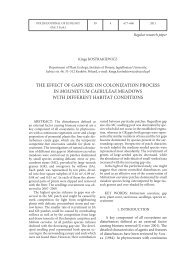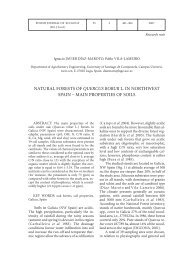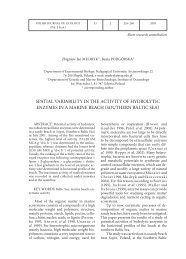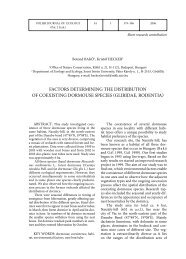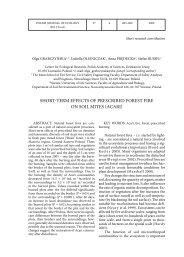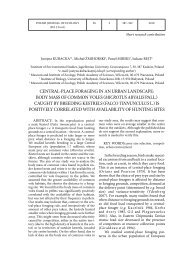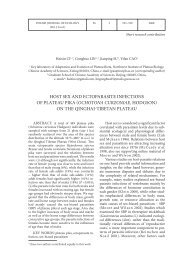FOOD PREFERENCES OF GLIS GLISï® L.ï¯, DRYOMYS NITEDULA ...
FOOD PREFERENCES OF GLIS GLISï® L.ï¯, DRYOMYS NITEDULA ...
FOOD PREFERENCES OF GLIS GLISï® L.ï¯, DRYOMYS NITEDULA ...
You also want an ePaper? Increase the reach of your titles
YUMPU automatically turns print PDFs into web optimized ePapers that Google loves.
POLISH JOURNAL <strong>OF</strong> ECOLOGY<br />
(Pol. J. Ecol.)<br />
54 3 369–378 2006<br />
Regular research paper<br />
Wojciech K. NOWAKOWSKI 1* , Magdalena REMISIEWICZ 2 , Joanna KOSOWSKA 1<br />
1<br />
Department of Zoology, University of Podlasie, Prusa 12, 08-110 Siedlce, Poland,<br />
e-mail: koszatek.wn@wp.pl (*corresponding author)<br />
2<br />
Avian Ecophysiology Unit, Department of Vertebrate Ecology and Zoology, University of Gdańsk,<br />
al. Legionów 9, 80-441 Gdańsk, Poland, e-mail: biomr@univ.gda.pl<br />
<strong>FOOD</strong> <strong>PREFERENCES</strong> <strong>OF</strong> <strong>GLIS</strong> <strong>GLIS</strong> (L.),<br />
<strong>DRYOMYS</strong> <strong>NITEDULA</strong> (PALLAS)<br />
AND GRAPHIURUS MURINUS (SMUTS)<br />
KEPT IN CAPTIVITY<br />
ABSTRACT: We investigated food preferences<br />
of three species of dormice, testing consumption<br />
by captive animals. One type of food<br />
was provided to an animal and its “suitability”<br />
scored for each species, according to whether it<br />
was or was not consumed. If it was eaten, the time<br />
when it was consumed was recorded (after 24, 48<br />
or 72 hours). In total, 17 types of animal food and<br />
46 of plant food were tested. Animal foods offered<br />
included different arthropods, eggs, snails<br />
and chicken meat. Plant food consisted of fruits,<br />
seeds, nuts and green parts. Glis glis consumed –<br />
24% of animal material offered and 100% of plant<br />
food types, Dryomys nitedula consumed – 77% of<br />
animal and 54% of plant food types. Graphiurus<br />
murinus consumed – 94% of animal and 63% of<br />
plant food types. G. glis showed a significantly<br />
higher preference for plant foods rather than<br />
animal material, and preferred plant food much<br />
more than the other two species. Both D. nitedula<br />
and G. murinus preferred animal more than plant<br />
food and did not differ in preferences and diversity<br />
of both kinds of food they consumed. Thus,<br />
G. glis can be considered as principally a herbivore,<br />
while D. nitedula and G. murinus are rather<br />
meat-eaters. It can be concluded that food niches,<br />
especially of the two European dormice, are separate<br />
and thus in natural conditions they do not<br />
compete strongly for food resources.<br />
KEY WORDS: diet, Glis glis, Dryomys nitedula,<br />
Graphiurus murinus, captivity<br />
1. INTRODUCTION<br />
The geographical ranges of the forest dormouse<br />
(Dryomys nitedula Pallas, 1779) and<br />
the edible dormouse (Glis glis L., 1766) overlap<br />
to a great extent (Storch 1978, Mitchell-Jones<br />
et al. 1999), at least in Europe,<br />
and these species live in similar (often the<br />
same) habitats (Pucek 1984, Nowakowski<br />
and B oratyński 1997, Nowakowski and<br />
Manowiec 2000). This might cause strong<br />
competitive interactions and replacement of<br />
one species by the other (Lozan et al. 1990).<br />
Thus, a shift in their ecological niches would<br />
be necessary to limit their competition. One<br />
of the most important resources is the food<br />
and it is why an ecological separation might<br />
be expected. Comparison of the diets of these<br />
two species with the food preferences of<br />
a relatively closely related species, the African<br />
woodland dormouse (Graphiurus murinus<br />
Smuts, 1832), seems interesting although<br />
the latter is not their competitor due to its<br />
different geographical range (Ajrapietjanc<br />
1983, Stuart and Stuart 1992).<br />
The diet of dormice (Gliridae, Rodentia),<br />
including the forest dormouse, edible<br />
dormouse and woodland dormouse, has not<br />
so far been very well described. Only a few<br />
journal 7.indb 369 2006-09-23 11:28:38
370 Wojciech K. Nowakowski et al.<br />
original studies investigated this issue in detail<br />
(e.g. Holišová 1968, Lozan et al. 1990,<br />
Franco 1990, Gigirey and Rey 1999),<br />
based on analysis of the content of stomachs<br />
of these rodents. Some authors state<br />
that the forest dormouse feeds mainly on<br />
plant food, but it also uses some animal food<br />
(S erafiński 1972, Głazaczow 1994). Other<br />
studies, however, show that at least in spring<br />
and summer arthropods and eggs, nestlings<br />
and even adult birds play an important role<br />
in their diet (Golodushko and Padutov<br />
1961, Angermann 1963, Holišová 1968,<br />
Lozan et al. 1990, Nowakowski 1995,<br />
Nowakowski and B oratyński 2000). Angermann<br />
(1963) stated that the forest dormouse<br />
probably used mainly the type of food<br />
most abundant in its habitat, and was thus<br />
a feeding opportunist. The food of the edible<br />
dormouse is thought to be buds, fruits and<br />
seeds of trees, bark and twigs, while animal<br />
food is only of supplementary importance<br />
(S erafiński 1972, Holišová 1968, Pucek<br />
1984, Lozan et al. 1990, Rossolimo et al.<br />
2001). Food of the woodland dormice is even<br />
less well known. It is described as composed<br />
of fruits, seeds, green parts of plants, arthropods<br />
and other invertebrates, also even small<br />
vertebrates such as tiny lizards (Stuart and<br />
Stuart 1992).<br />
The present paper is aimed at a comparison<br />
of diets of the forest dormouse, edible dormouse<br />
and woodland dormouse, particularly<br />
their preferences for different types of food.<br />
2. MATERIAL AND METHODS<br />
Food preferences of the forest dormouse,<br />
edible dormouse and woodland dormouse<br />
were studied based on the analysis of results<br />
of feeding tests performed in captivity. Experiments<br />
were conducted with 8 forest dormice<br />
(4 males, 4 females), 5 edible dormice<br />
(3 males, 2 females) kept in separate cages,<br />
and 8 woodland dormice (3 males, 5 females)<br />
all kept in one cage. The studies were conducted<br />
in 1995–1999 in the case of the forest<br />
and the edible dormice and in 2000–2002 for<br />
woodland dormice.<br />
During experiments animals were provided<br />
with the following types of food,<br />
grouped in categories (for details – see Appendix):<br />
• animal food (17 types in total) – arthropods:<br />
different species and development<br />
stages; other: bird eggs (of different sizes,<br />
fresh or boiled), snails (with and without<br />
shells), chicken meat;<br />
• plant food (46 types in total) – soft:<br />
fruits (different types), green parts of plants<br />
(leaves, flowers, leaf and flower buds, twigs<br />
with bark of different trees), seeds; hard:<br />
stones of fruits, nuts (different kinds, including<br />
acorns, with and without shells).<br />
For each rodent, the composition of tested<br />
food was the same and included 63 types<br />
in total.<br />
In the case of animals kept separately,<br />
every individual was given each type of food,<br />
so that for forest dormice a total of 504 tests<br />
were performed, for edible dormice there<br />
were 315 tests, and for the group of woodland<br />
dormice there were 63 tests. A test consisted<br />
of providing an animal with a certain type of<br />
food, in a cage previously cleaned from all<br />
materials that could be consumed. In a cage<br />
there was only a wooden nestbox lined with<br />
soft paper shavings, pine twigs without bark,<br />
ball-drinker with water and a metal bowl<br />
with the food being offered. Food was provided<br />
at noon (dormice are not active during<br />
the day) in a strictly determined amount<br />
e.g. 20 seeds of oats, a quarter of an apple<br />
or 10 larvae of mealworm. After 24, 48 and<br />
72 hours the cage was checked if food had<br />
been consumed. The test ceased after the<br />
first sign that the given food had been eaten,<br />
or after 72 hours to avoid the animals dying<br />
from starvation. Suitability of a given food<br />
type for a species was defined by the “preference<br />
score” on a four-point scale (scores<br />
0–3), depending on the period in which the<br />
food was eaten – during the first 24 hours<br />
(immediately) scored 3, during the second<br />
24 hours = 2, during the third 24 hours =<br />
1. Food that was not taken during 72 hours<br />
was assumed not to have been eaten, and recorded<br />
as “unsuitable for the species”. This<br />
was scored as 0. In cases where animals kept<br />
singly did not eat certain foods but the same<br />
was willingly consumed by another individual,<br />
the food was given the highest obtained<br />
score. For example, two edible dormice ate<br />
crickets during the first 24 hours, two others<br />
in 48 hours and one did not eat them at<br />
all; the score given was 3. For at least two<br />
journal 7.indb 370 2006-09-23 11:28:39
Food preferences of three species of dormice<br />
371<br />
days between successive tests, each animal<br />
was provided with full nutritive quality food<br />
ad libitum – a standard mix of pellets for rodents<br />
enriched with protein grain food and<br />
fruits.<br />
To compare the diversity of animal and<br />
plant food consumed by the species studied,<br />
one-tailed test of differences between percent<br />
indices was applied (Stanisz 1998). The<br />
level of the animals’ preferences for different<br />
food categories were compared between species<br />
of dormice and food types by testing the<br />
distributions of their preference scores using<br />
a Mann-Whitney U-test or Kruskall-Wallis<br />
(K-W) test, with post-hoc Dunn test. Normally,<br />
a level of significance of P
372 Wojciech K. Nowakowski et al.<br />
foods, while the woodland dormouse consumed<br />
only 14% of types of hard plant food<br />
(Table 1). The food of the forest dormouse<br />
and the woodland dormouse was significantly<br />
richer in species and forms of arthropods<br />
than in the edible dormouse, but their plant<br />
food was significantly less diverse in both<br />
hard and soft food types (Table 2).<br />
Only the edible dormouse ate all kinds<br />
of plant food (100%) offered, as shown in<br />
Table 3. Among the categories of plant food<br />
distinguished (see Appendix), the edible<br />
dormouse did not show any clear preferences<br />
(K-W test: H 3,46<br />
= 7.02; P
Food preferences of three species of dormice<br />
373<br />
less, they consumed more than 70% of all<br />
types of seeds available (Table 3). It is interesting<br />
that fewer types of nuts and green<br />
parts of plants were consumed by the forest<br />
dormouse and the woodland dormouse<br />
than by the edible dormouse (Table 4). This<br />
was confirmed by the analysis of suitability<br />
of different types to the first two species. In<br />
the forest dormouse the preference scores<br />
differed between the categories of plant<br />
food (K-W test: H 3,46<br />
= 16.77; P
374 Wojciech K. Nowakowski et al.<br />
4. DISCUSSION<br />
Comprehensive information on the food<br />
of dormice is scarce in the literature, particularly<br />
in respect of the woodland dormouse.<br />
In monographs or handbooks (e.g. Angermann<br />
1963, Ajrapetjanc 1983, Pucek<br />
1984, Lozan et al. 1990, Rossolimo et al.<br />
2001) a general description of the animals’<br />
food can be found among other aspects described.<br />
However, it is usually difficult to<br />
compare actual food preferences of these<br />
species due to small samples or lack of comparable<br />
conditions.<br />
One of the following methods is usually<br />
applied when describing food composition:<br />
examination of stomach contents (e.g.<br />
Holišova 1968, Lozan et al. 1990), analysis<br />
of faeces (e.g. Abt and B ock 1998) and<br />
results of experimental feeding (e.g. Ajrapetjanc<br />
1983, Lozan et al. 1990, Gigirey<br />
and Rey 1999). The most reliable seems to<br />
be the analysis of stomach contents, however<br />
in the case of rare and protected animals (in<br />
Poland the forest dormouse and the edible<br />
dormouse are legally protected and listed in<br />
the Polish Red Data Book of Animals, 2001)<br />
non-invasive methods that do not require<br />
killing animals seem much more appropriate.<br />
The method used in this study allowed<br />
for direct comparison of food preferences<br />
among the three rodent species described,<br />
despite that the geographical range of one is<br />
not overlapped with the ranges of the other<br />
two species. Nevertheless, the results obtained<br />
should be treated cautiously, as in natural<br />
conditions animals are never confronted<br />
with only a single type of food (they have always<br />
some choice of food available and diet<br />
supplementation). In addition, under experimental<br />
conditions the animals were provided<br />
with types of food they might never normally<br />
find in the wild (e.g. hen egg or banana in<br />
the case of two European dormice). The results<br />
presented also do not show directly the<br />
real proportion of specified types of food in<br />
the diet of dormice. For example, the forest<br />
dormouse consumed in captivity the flowers<br />
of Oxalis acetosella as willingly as moths<br />
(both reached the highest preference score),<br />
but in nature these food types will play different<br />
roles in the diet due to their differing<br />
availability.<br />
The forest dormouse feeds mainly on<br />
animal food, as described by many authors,<br />
although some discrepancies occur between<br />
the published results and results presented<br />
here (Angermann 1963, Holišova<br />
1968, Lozan et al. 1990, Rossolimo et<br />
al. 2001). The preference of this species for<br />
animal food was fully confirmed by the results<br />
obtained in the present study. The results<br />
presented here are closer to those from<br />
Moldova (Lozan et al. 1990) than from<br />
Russia (Rossolimo et al. 2001), but they<br />
allow the addition of diplopods as willingly<br />
eaten food to the diet of the species. Feeding<br />
tests showed that the forest dormouse<br />
avoided the very hairy caterpillars of Callimorpha,<br />
which is in accordance with Angermann<br />
(1963). Some studies show that<br />
the forest dormouse will also eat snails, but<br />
they do not specify which species (Angermann<br />
1963, Holišova 1968, Rossolimo<br />
et al. 2001). In the present study we did<br />
not confirm these observations and nor did<br />
other authors mention them as components<br />
of the forest dormouse diet (Lozan et al.<br />
1990). Thus a question arises as to whether<br />
snails offered in the present experiments<br />
were unsuitable (e.g. too large) or whether<br />
they are a marginal component of the forest<br />
dormouse diet, consumed only accidentally<br />
or in cases of extreme need. It is interesting<br />
that eggs and birds (small passerines)<br />
are consumed by this rodent in high numbers<br />
(Nowakowski 1995, Nowakowski<br />
and B oratyński 2000), but have not been<br />
noted in its diet by some other authors<br />
(Holišova 1967, Lozan et al. 1990). The<br />
results presented here prove the ability of<br />
the forest dormouse to destroy broods of<br />
small passerines, but not those of larger<br />
birds (e.g. of quail size).<br />
Although these experiments support<br />
existing evidence for a limited role of plant<br />
food for the forest dormouse (Angermann<br />
1963, Holišova 1968, Lozan et al. 1990,<br />
Rossolimo et al. 2001), some discrepancies<br />
can be found. It seems unimportant that<br />
this species did not consume oats during the<br />
tests, although Lozan et al. (1990) included<br />
this type of food to its diet. However, it<br />
is striking that despite observations made<br />
by other authors (Lozan et al. 1990), during<br />
the present study forest dormice did not<br />
journal 7.indb 374 2006-09-23 11:28:39
Food preferences of three species of dormice<br />
375<br />
eat hazelnuts, walnuts in shells or hornbeam<br />
nuts. Perhaps forest dormice eat only unripe<br />
nuts with relatively soft shells –in nestboxes<br />
inhabited by forest dormice we sometimes<br />
found shells of unripe hazelnuts (authors’<br />
unpubl. data). In the relevant literature it was<br />
suggested that the forest dormouse was unable<br />
to open such nuts due to the size and<br />
structure of its teeth (Angermann 1963).<br />
Another inconsistency in descriptions of the<br />
diet of forest dormice concerns eating bark.<br />
This was sometimes recorded (Rossolimo<br />
et al. 2001), but in other studies including the<br />
present one, consumption of bark was not<br />
observed (Holišova 1968).<br />
In contrast to the forest dormouse, the<br />
edible dormouse feeds mainly on plant food.<br />
This has been demonstrated by the results<br />
here as well as in the literature (Holišova<br />
1968, Lozan et al. 1990, Franco 1990, Gigirey<br />
and Rey 1999). This rodent eats all<br />
types of plant food and does not avoid flowers,<br />
buds or bark. The present study did not<br />
show any clear preferences by this species<br />
for a single type or a category of plant food.<br />
However, the study of Gigirey and Rey<br />
(1999) clearly defined preferences of the edible<br />
dormouse in this respect. Among the<br />
invertebrates provided, the edible dormouse<br />
consumed moths and crickets, but did not<br />
eat beetles (imagines) or any caterpillars or<br />
snails. This could be expected based on information<br />
in the literature (Holišova 1968,<br />
Lozan et al. 1990).<br />
Knowledge of the woodland dormouse<br />
is even more limited, except for very general<br />
statements. It is said to be omnivorous and<br />
can eat lizards, arthropods and other invertebrates,<br />
but also it consumes commonly<br />
fruits, seeds and other parts of plants (Ajrapetjanc<br />
1983, Stuart and Stuart 1992).<br />
Data on food preferences of this species are<br />
lacking. The results presented here confirm<br />
omnivory in this species, but have a comparative<br />
rather than descriptive nature. It<br />
is shown that they avoid hard types of food<br />
such as nuts, despite their high nutritional<br />
value. This is may be due to having smaller<br />
and weaker teeth and jaws than in the two<br />
other species studied.<br />
The most interesting aspect of the present<br />
study is the comparison of diets, in<br />
particular of the forest and edible dormice<br />
which are potential competitors (Storch<br />
1978, Lozan et al. 1990, Nowakowski<br />
and B oratyński 1997, Nowakowski and<br />
Manowiec 2000). It appears that the glirid<br />
species studied are omnivorous, but they<br />
use certain categories of food to a different<br />
extent. The forest dormouse and the woodland<br />
dormouse are predators to a much<br />
greater extent that the edible dormouse,<br />
and the woodland dormouse appeared to<br />
be the most omnivorous species of those<br />
compared. In the light of the present results<br />
it can be stated that the forest dormouse<br />
and the edible dormouse probably do not<br />
compete for food resources in natural conditions.<br />
5. REFERENCES<br />
Abt K.F., B ock W.F. 1998 – Seasonal variations<br />
of diet composition in farmland field<br />
mice Apodemus spp. and bank voles Clethrionomys<br />
glareolus – Acta Theriol. 43: 379–389.<br />
Ajrapetjanc A.E. 1983 – Soni [Dormice]<br />
– Izd. Len. Univ., Leningrad (in Russian).<br />
Angermann R . 1963 – Zur Ökologie und Biologie<br />
des Baumschläfers, Dryomys nitedula<br />
(Pallas, 1779) in der Waldsteppenzone – Acta<br />
Theriol. 7: 333–367.<br />
Franco D. 1990 – Feeding habits of a dormouse<br />
population (Myoxus glis) of the Asiago Plateau<br />
(Venetian Prealps) – Hystrix (n.s.) 2: 11–22.<br />
Gigirey A., Rey J.M. 1999 – Faecal analysis<br />
of the edible dormouse (Glis glis) in the northwest<br />
Iberian Peninsula – Z. Säugetierkunde<br />
64: 376–379.<br />
Głazaczow A. 1994 – Ssaki [Mammals]. (In:<br />
Zwierzęta chronione w Polsce [Animals protected<br />
in Poland] Eds. A. Winiecki, A. Nowosad,<br />
A. Głazaczow) – FBE, Poznań, pp.<br />
211–233 (in Polish).<br />
Golodushko B.Z., Padutov E.E. 1961<br />
– Materialy po ekologii lesnoj soni Bieloviezskoj<br />
Pushchy. (In: Fauna i ekologija nazemnyh<br />
pozvonochnyh Belorussii) – Minsk, pp. 49–70<br />
(in Russian).<br />
Holišová V. 1968 – Notes on the food of dormice<br />
(Gliridae) – Zoologické Listy, 17: 109–<br />
114.<br />
Lozan M., Belik L., Samarskij S. 1990<br />
– Soni (Gliridae) jugo-zapada SSSR [Dormice<br />
(Gliridae) of south-west USSR] – Kishinev.<br />
(in Russian).<br />
Mitchell-Jones A., Amori G., Bogdanowicz<br />
W., Kryštufek B., Reijnders P.J.D.,<br />
Spitzenberger F., Stubbe M., Thissen<br />
journal 7.indb 375 2006-09-23 11:28:40
376 Wojciech K. Nowakowski et al.<br />
J.B.M., Vorhalík V., Zima J. 1999 – The<br />
atlas of European mammals – Academic Press<br />
T & A D Poyser Ltd.<br />
Nowakowski W.K. 1995 – Koszatka –<br />
drapieżny gryzoń [The forest dormouse –<br />
a predator rodent] – Ptaki (Biuletyn OTOP)<br />
3: 5 (in Polish).<br />
Nowakowski W.K., Boratyński P. 1997<br />
– Habitat preferences of the forest dormouse<br />
(Dryomys nitedula) in lowland forests – Pol.<br />
ecol. Stud. 23: 199–207.<br />
Nowakowski W.K., Boratyński P. 2000<br />
– O identyfikacji śladów drapieżnictwa<br />
w skrzynkach lęgowych [Notes on identificantion<br />
of signs of predation] – Not. Orn. 41:<br />
55–69 (in Polish with English summary).<br />
Nowakowski W.K., Manowiec E. 2000<br />
– Preferencje środowiskowe popielicy<br />
w Puszczy Białowieskiej [Habitat preferences<br />
of the edible dormouse in Białowieża Forest]<br />
– Kulon 5: 81–89 (in Polish).<br />
Pucek Z. (ed.) 1984 – Klucz do oznaczania<br />
ssaków Polski [Key to identification of Polish<br />
mammals] – PWN – Polish Scientific Publishers,<br />
Warszawa (in Polish).<br />
Rossolimo O.L., Popov E.G., Pavlinov<br />
I.J., Kruskop S.W., Voltzit O.W. 2001<br />
– Soni (Myoxidae) mirovoj fauny [Dormice<br />
(Myoxidae) of the world] – Russian Academy<br />
of Sciences, Moscow (in Russian).<br />
S erafiński W. 1972 – Ssaki Polski [Mammals<br />
of Poland] – PZWS, Warszawa (in Polish).<br />
Stanisz A. 1998 – Przystępny kurs statystyki<br />
[Approachable course of statistica] – Statsoft,<br />
Kraków (in Polish).<br />
Storch von G. 1978 – Familie Gliridae Thomas,<br />
1897 – Schläfer. (In: Handbuch der Säugetiere<br />
Europas, Eds. J. Niethammer, F. Krapp)<br />
– Akademi Verlagsgesellschaft, Wiesbaden, 1,<br />
pp. 202–280.<br />
Stuart C., Stuart T. 1992 – Mammals of<br />
Southern Africa – Struik Publishers, Cape<br />
Town.<br />
Z ar J.H. 1999 – Biostatistical Analyses – Prentice-Hall,<br />
Inc., Upper Saddle River, New Jersey.<br />
(Received after revising June 2006)<br />
journal 7.indb 376 2006-09-23 11:28:40
Food preferences of three species of dormice<br />
377<br />
Appendix. Scores of preference 0–3 (food eating during the first 24 hours = 3, during the second 24<br />
hours = 2, during the third 24 hours = 1; food not taken during 72 hours =0) of the three species of dormice<br />
studied, for different types of food, with the classification of food into categories: A – arthropods,<br />
O – other animal food, N – nuts, S – seeds, F – fruits, G – green parts, H – hard, T – soft.<br />
Food type<br />
Food category<br />
Forest dormouse<br />
(D. nitedula)<br />
Edible dormouse<br />
(G. glis)<br />
Woodland<br />
dormouse<br />
(G. murinus)<br />
Larva Tenebrio sp. A 3 0 3<br />
Coleopteran (imago) Tenebrio sp. A 3 0 3<br />
Coleopteran (imago) Geotrupes sp. A 1 0 3<br />
Maggot Musca domestica A 3 0 3<br />
Imago Musca domestica A 3 0 3<br />
Imago Gryllus campestris A 3 3 3<br />
Imago Hemiptera sp. A 3 0 3<br />
Diplopoda A 3 0 3<br />
Lepidoptera (moths) A 3 3 3<br />
Caterpillar Piersi sp. A 3 0 3<br />
Caterpillar Callimorpha sp. A 0 0 3<br />
Egg of hen boiled – without shell O 3 2 3<br />
Egg Paridae – in shell O 3 0 3<br />
Egg Coturnix coturnix – in shell O 0 0 0<br />
Cepaea sp. O 0 1 3<br />
Arion sp. O 0 0 3<br />
Fresh chicken meet – strips O 3 0 3<br />
Avena sp. – grains ST 1 2 2<br />
Triticum sp. – grains ST 0 2 1<br />
Zea sp. – grains ST 2 3 3<br />
Helianthus sp. – inflorescence ST 3 3 3<br />
Cucurbita sp. – stones ST 3 3 3<br />
Prunus cerasus – stones SH 2 3 0<br />
Acer platanoides – seeds ST 0 2 0<br />
Corylus avellana – nut without shells NT 3 3 3<br />
Juglans regia – nut without shells NT 3 3 3<br />
Pistacja sp. – nut without shells NT 3 3 3<br />
Arachid hypogaea – fruit without shells NT 3 3 3<br />
Corylus avellana – nut in shell NH 0 3 0<br />
Juglans regia – nut in shell NH 0 3 0<br />
Pistacja sp. – nut in shell NH 0 3 0<br />
Arachid hypogaea – fruit in shell NH 3 3 1<br />
Carpinus betulus – nut NH 0 3 0<br />
Quercus sp. – acorns NH 3 3 0<br />
Tilia cordata – fruit FT 3 3 3<br />
Malus domestica – fruit FT 3 3 3<br />
Pyrus communis – fruit FT 3 3 3<br />
Prunus domestica – fruit FT 3 3 3<br />
Prunus cerasus – fruit without shell FT 3 3 3<br />
journal 7.indb 377 2006-09-23 11:28:40
378 Wojciech K. Nowakowski et al.<br />
Food type<br />
Food category<br />
Forest dormouse<br />
(D. nitedula)<br />
Edible dormouse<br />
(G. glis)<br />
Woodland<br />
dormouse<br />
(G. murinus)<br />
Rubus sp. – fruit FT 3 3 3<br />
Sorbus aucuparia – fruit FT 2 3 3<br />
Sambucus nigra – fruit FT 2 3 2<br />
Musa paradisiaca – fruit without skin FT 2 2 3<br />
Tilia cordata – leaf buds GT 0 3 3<br />
Corylus avellana – leaf buds GT 2 3 3<br />
Syringa vulgaris – leaf buds GT 0 3 3<br />
Prunus cerasus – leaf buds GT 2 3 3<br />
Oxalis acetosella – leaves GT 0 3 0<br />
Fragaria sp.– leaves GT 0 3 0<br />
Mycelis muralis – leaves GT 1 3 0<br />
Viola sp. – leaves GT 0 3 0<br />
Anemone nemorosa – leaves GT 0 3 0<br />
Lactuca sp. – leaves GT 0 3 0<br />
Spinacia oleracea – leaves GT 1 3 1<br />
Brassica oleracea – leaves GT 0 2 0<br />
Brassica pekinensis – leaves GT 0 3 3<br />
Aloe vera – leaves GT 0 2 3<br />
Anemone nemorosa – flowers GT 0 3 0<br />
Fragaria sp. – flowers GT 2 3 0<br />
Oxalis acetosella – flowers GT 3 3 3<br />
Tilia cordata – bark, twigs GT 0 3 2<br />
Corylus avellana– bark, twigs GT 0 3 2<br />
Syringa vulgaris – bark, twigs GT 0 3 2<br />
journal 7.indb 378 2006-09-23 11:28:40




